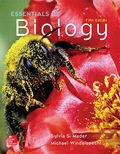
Concept explainers
To explain:
The way through which the genetic engineering is utilized in the asexual reproduction.
Introduction:
The genetic engineering can be defined as the manipulation of genetic material of a living organism using
Explanation of Solution
The asexual reproduction involves only a single parent. As the asexual reproduction does not involve the process of fertilization, the daughter cells formed by the process are genetically identical. Some of the plants such as the gladiolas, irises, and tulips are not grown from the seeds, rather they reproduce asexually.
To introduce changes in the asexually growing plants, the genetic engineering is used. The genetic engineering allows the scientists to provide a better quality of plants. The genetic engineering techniques that can be used to alter the genetic material are the the transformation technique and particle gun method .
The transformation technique uses the bacterium Agrobacterium tumefaciens, which induces gall formation in the plants. The gene for gall or tumor formation present in the plasmid is replaced with the desired gene. The plasmid with the desired gene incorporates into the chromosome of the plants and expresses itself. Another technique of genetic engineering is the gene gun. The gene contains a gold particle which is coated with the desired gene and is targeted to the cell. The transformed cell is then allowed to grow in the tissue culture.
The asexual reproduction utilizes the genetic engineering in two ways; namely the transformation technique involving the Agrobacterium tumefaciens and gene gun. Through these techniques, the desired gene can be inserted into the cell, which is then allowed to grow in the tissue cultures.
Want to see more full solutions like this?
Chapter 21 Solutions
Essentials of Biology (5th International Edition)
 Human Anatomy & Physiology (11th Edition)BiologyISBN:9780134580999Author:Elaine N. Marieb, Katja N. HoehnPublisher:PEARSON
Human Anatomy & Physiology (11th Edition)BiologyISBN:9780134580999Author:Elaine N. Marieb, Katja N. HoehnPublisher:PEARSON Biology 2eBiologyISBN:9781947172517Author:Matthew Douglas, Jung Choi, Mary Ann ClarkPublisher:OpenStax
Biology 2eBiologyISBN:9781947172517Author:Matthew Douglas, Jung Choi, Mary Ann ClarkPublisher:OpenStax Anatomy & PhysiologyBiologyISBN:9781259398629Author:McKinley, Michael P., O'loughlin, Valerie Dean, Bidle, Theresa StouterPublisher:Mcgraw Hill Education,
Anatomy & PhysiologyBiologyISBN:9781259398629Author:McKinley, Michael P., O'loughlin, Valerie Dean, Bidle, Theresa StouterPublisher:Mcgraw Hill Education, Molecular Biology of the Cell (Sixth Edition)BiologyISBN:9780815344322Author:Bruce Alberts, Alexander D. Johnson, Julian Lewis, David Morgan, Martin Raff, Keith Roberts, Peter WalterPublisher:W. W. Norton & Company
Molecular Biology of the Cell (Sixth Edition)BiologyISBN:9780815344322Author:Bruce Alberts, Alexander D. Johnson, Julian Lewis, David Morgan, Martin Raff, Keith Roberts, Peter WalterPublisher:W. W. Norton & Company Laboratory Manual For Human Anatomy & PhysiologyBiologyISBN:9781260159363Author:Martin, Terry R., Prentice-craver, CynthiaPublisher:McGraw-Hill Publishing Co.
Laboratory Manual For Human Anatomy & PhysiologyBiologyISBN:9781260159363Author:Martin, Terry R., Prentice-craver, CynthiaPublisher:McGraw-Hill Publishing Co. Inquiry Into Life (16th Edition)BiologyISBN:9781260231700Author:Sylvia S. Mader, Michael WindelspechtPublisher:McGraw Hill Education
Inquiry Into Life (16th Edition)BiologyISBN:9781260231700Author:Sylvia S. Mader, Michael WindelspechtPublisher:McGraw Hill Education





